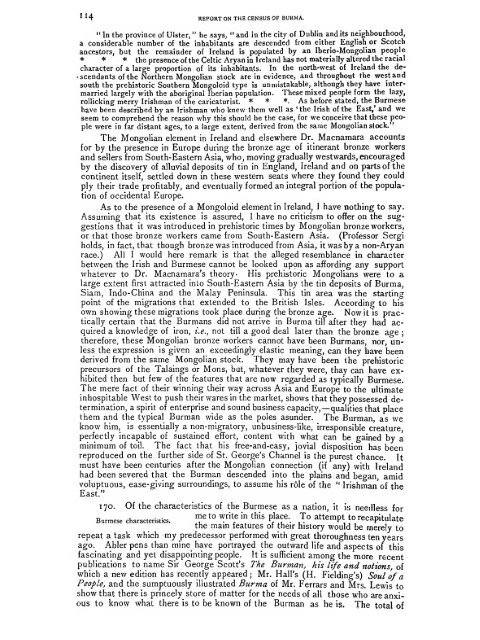Burma: Census of India 1901 Vol. I - Khamkoo
Burma: Census of India 1901 Vol. I - Khamkoo
Burma: Census of India 1901 Vol. I - Khamkoo
You also want an ePaper? Increase the reach of your titles
YUMPU automatically turns print PDFs into web optimized ePapers that Google loves.
1 '<br />
4<br />
REPORT ON THE CENSUS OF BURMA.<br />
" In the province <strong>of</strong> Ulster, " he says.. " and in the city <strong>of</strong> Dublin and its neighbourhood,<br />
a considerable number <strong>of</strong> the inhabitants are descended from either English or Scotch<br />
ancestors, but the remainder <strong>of</strong> Ireland is populated by an Iberio-Mongolian people<br />
* * * the presence <strong>of</strong> the Celtic Aryan in Ireland has not materially altered the racial<br />
character <strong>of</strong> a large proportion <strong>of</strong> its inhabitants. In the north-west <strong>of</strong> Ireland the de-<br />
• scendants <strong>of</strong> the Northern Mongolian stock are in evidence, and throughout the west and<br />
south the prehistoric Southern Mongoloid type is unmistakable, although they have intermarried<br />
largely with the aboriginal Iberian population. These mixed people form the lazy,<br />
rollicking merry Irishman <strong>of</strong> the caricaturist. * * * As before stated, the Burmese<br />
have been described by an Irishman who knew them well as the ' Irish <strong>of</strong> the East,' and we<br />
seem to comprehend the reason why this should be the case, for we conceive that these people<br />
were in far distant ages, to a large extent, derived from the same Mongolian stock."<br />
The Mongolian element in Ireland and elsewhere Dr. Macnamara accounts<br />
for by the presence in Europe during the bronze age <strong>of</strong> itinerant bronze workers<br />
and sellers from South-Eastern Asia, who, moving gradually westwards, encouraged<br />
by the discovery <strong>of</strong> alluvial deposits <strong>of</strong> tin in England, Ireland and on parts <strong>of</strong> the<br />
continent itself, settled down in these western seats where they found they could<br />
ply their trade pr<strong>of</strong>itably, and eventually formed an integral portion <strong>of</strong> the population<br />
<strong>of</strong> occidental Europe.<br />
As to the presence <strong>of</strong> a Mongoloid element in Ireland, I have nothing to say.<br />
Assuming that its existence is assured, I have no criticism to <strong>of</strong>fer on the suggestions<br />
that it was introduced in prehistoric times by Mongolian bronze workers,<br />
or that those bronze workers came from South-Eastern Asia. (Pr<strong>of</strong>essor Sergi<br />
holds, in fact, that though bronze was introduced from Asia, it was by a non-Aryan<br />
race.) All I would here remark is that the alleged resemblance in character<br />
between the Irish and Burmese cannot be looked upon as affording any support<br />
whatever to Dr. Macnamara's theory- His prehistoric Mongolians were to a<br />
large extent first attracted into South-Eastern Asia by the tin deposits <strong>of</strong> <strong>Burma</strong>,<br />
Siam, Indo-China and the Malay Peninsula. This tin area was the starting<br />
point <strong>of</strong> the migrations that extended to the British Isles. According to his<br />
own showing these migrations took place during the bronze age. Now it is practically<br />
certain that the <strong>Burma</strong>ns did not arrive in <strong>Burma</strong> till after they had acquired<br />
a knowledge <strong>of</strong> iron, i.e., not till a good deal later than the bronze age ;<br />
therefore, these Mongolian bronze workers cannot have been <strong>Burma</strong>ns, nor, unless<br />
the expression is given an exceedingly elastic meaning, can they have been<br />
derived from the same Mongolian stock. They may have been the prehistoric<br />
precursors <strong>of</strong> the Talaings or Mons, but, whatever they were, thay can have exhibited<br />
then but few <strong>of</strong> the features that are now regarded as typically Burmese.<br />
The mere fact <strong>of</strong> their winning their way across Asia and Europe to the ultimate<br />
inhospitable West to push their wares in the market, shows that they possessed determination,<br />
a spirit <strong>of</strong> enterprise and sound business capacity, — qualities that place<br />
them and the typical <strong>Burma</strong>n wide as the poles asunder. The <strong>Burma</strong>n, as we<br />
know him, is essentially a non-migratory, unbusiness-like, irresponsible creature<br />
perfectly incapable <strong>of</strong> sustained effort, content with what can be gained by a<br />
minimum <strong>of</strong> toil. The fact that his free-and-easy, jovial disposition has been<br />
reproduced on the further side <strong>of</strong> St. George's Channel is the purest chance. It<br />
must have been centuries after the Mongolian connection (if any) with Ireland<br />
had been severed that the <strong>Burma</strong>n descended into the plains and began, amid<br />
voluptuous, ease-giving surroundings, to assume his role <strong>of</strong> the " Irishman <strong>of</strong> the<br />
East."<br />
1 70. Of the characteristics <strong>of</strong> the Burmese as a nation, it is needless for<br />
J° atte Pt JO recapitulate<br />
Burmese characteristics.<br />
Jf t0 ^5 in this Pk f<br />
".<br />
the mam features <strong>of</strong> their history would be merely to<br />
repeat a task which -my predecessor performed with great thoroughness ten years<br />
ago. Abler pens than mine have portrayed the outward life and aspects <strong>of</strong> this<br />
fascinating and yet disappointing people. It is sufficient among the more recent<br />
publications to name Sir George Scott's The <strong>Burma</strong>n, his life and notions, <strong>of</strong><br />
which a new edition has recently appeared ;<br />
Mr. Hall's (H. Fielding's) Soul <strong>of</strong> a<br />
People, and the sumptuously illustrated <strong>Burma</strong> <strong>of</strong> Mr. Ferrars and Mrs. Lewis to<br />
show that there is princely store <strong>of</strong> matter for the needs <strong>of</strong> all those who are anxious<br />
to know what there is to be known <strong>of</strong> the <strong>Burma</strong>n as he is. The total <strong>of</strong>

















